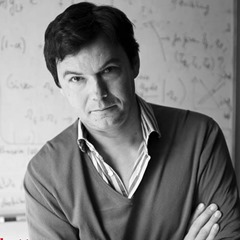Closing the inequality gap
 Tom Healy, Director of the Nevin Economic Research Institute, reviews the big picture of economic inequality as described by Thomas Piketty and suggests that more detail is needed on how to generate more revenue.
Tom Healy, Director of the Nevin Economic Research Institute, reviews the big picture of economic inequality as described by Thomas Piketty and suggests that more detail is needed on how to generate more revenue.
“It is hard to imagine an economy and a society that can continue functioning indefinitely with such extreme divergence between social groups.”
So writes Thomas Piketty.
in his book ‘Capital in the Twenty-First Century’. Piketty recently visited Ireland and attracted considerable publicity and interest including a packed conference of many hundreds in Dublin.
What ‘Capital in the Twenty-First Century’ has done is as follows:
• put the question of economic inequality back on the agenda more than ever in recent times;
• gone about tracking trends in inequality (exhaustively) from available international and national data sources;
• moved from mere analysis to policy recommendation (at the global level) by proposing co-ordinated international policy action in the field of taxation.
Because Piketty has undertaken a huge sweep of analysis covering two centuries and sometimes more, and a number of countries for which data were available (principally the USA, Britain and France), he enables readers to acquire a bigger picture than analysis which is heavily constrained by reference to time, country or type of income or wealth. Piketty goes for the ‘big picture’ and, in typical French style, seeks a synthesis of evidence and theories to understand why particular trends and changes emerged at different points in history.
Unfortunately, in the case of Ireland, data are not readily available on long-term trends in income inequality. However, some data are available from the World Top Income Database (WTID). Professor Brian Nolan of UCD has provided important historical data to the WTID. The data shown in the chart opposite is based on gross individual income (before deduction of taxes) at different points in time going back to the mid-1970s and including estimates for 1938 and 1943.
The data suggest a trend towards growing inequality since at least the 1970s. However, when account is taken of the redistributed effects of taxation and social transfers, inequality is much less and it is not necessarily the case that post-distribution income has increased that much, if at all, in the case of Ireland. As for capital wealth, there are no consistent or comprehensive data on distribution. Based on data in other countries, it is certain that wealth is more unequally distributed than income.
 Piketty champions the notion of a tax on capital – albeit an internationally co-ordinated one. This is troubling for many current-day Irish policy-makers and commentators because taxes, especially those on income or capital, are viewed as ‘bads’ to be minimised as much as possible for the express purpose of the least necessary public service consistent with an internationally competitive low tax regime (whether on incomes of corporations or individuals). The overriding economic strategy is to rely very heavily on foreign inward investment including trade in financial services based on a competitive low tax model.
Piketty champions the notion of a tax on capital – albeit an internationally co-ordinated one. This is troubling for many current-day Irish policy-makers and commentators because taxes, especially those on income or capital, are viewed as ‘bads’ to be minimised as much as possible for the express purpose of the least necessary public service consistent with an internationally competitive low tax regime (whether on incomes of corporations or individuals). The overriding economic strategy is to rely very heavily on foreign inward investment including trade in financial services based on a competitive low tax model.
However, ‘Capital in the Twenty-First Century’ should not be viewed as a generalised case for more taxation everywhere – at least not in those parts of the world where taxation/government revenue or public spending is in the order of 50 per cent (such as it is some European countries including France and the Nordic countries). Piketty argues for better use of taxation and ‘modernisation’ of the social state (always an ambiguous term when it comes to social policy). What he does argue for is a global (or continental or regional) tax on capital wealth.
This is a timely intervention because of rising social inequality and exclusion in many parts of Europe and the risk of fraying in the bonds of civic support and engagement at national member state or EU community level. In absence of significant growth in output and employment, a policy of austerity is likely to embed long-term unemployment or under-employment. However, the real elephant in the room is the unsustainability of a carbon-fuelled pattern of consumption and production aided and abetted by a global system of finance capital that is largely out of control.
Piketty places much emphasis on the taxation of capital wealth without spelling out in any detail how it would be implemented. He sees it, correctly, as an inter-state and global challenge. Attempts to levy significant one-off or continuous taxes on wealth in the context of free movement of capital are likely to be self-defeating as capital can move.
The solution is to agree on internationally binding taxes allied to good information obtained as a result of international treaties and data-sharing protocols involving banks, tax authorities and other agencies.
All of this might seem like a pipe dream in today’s Europe – largely governed by ideas and interests inimical to the sort of values and ideas promoted by Piketty.
However, we must live in hope that some lessons have been learned from the history of the recent century and change is possible.
Capital in the Twenty-First Century is published by Harvard University Press.





